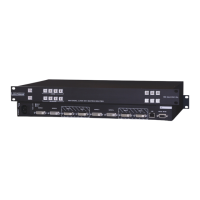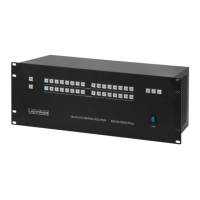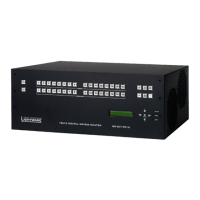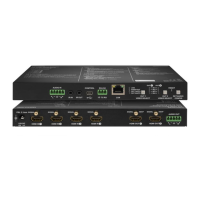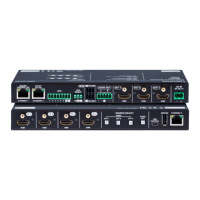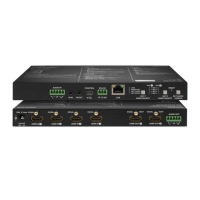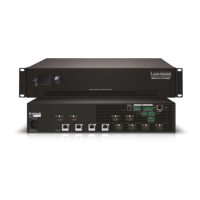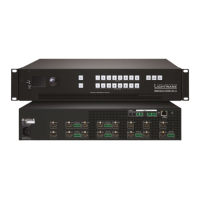Standalone MX DVI-Plus family
User’s Manual
Section 1. Introduction Page 9 / 89
1.3. Features
Advanced EDID Management – The user can emulate any EDID on the switcher's
inputs independently, read out and store any attached monitor's EDID in 100 internal
memory locations, upload and download EDID files using Lightware Device Control
Software.
Non-blocking cross point matrix architecture – The router allows any input to be
switched to any output or more outputs simultaneously.
2.25 Gb/s channel transmission – Routes any DVI single link and HDMI signal
between 25 and 225 MHz pixel clock frequency conforming to DVI and HDMI standards.
Supports all HDTV resolutions – 720p, 1080i, 1080p 2K etc. HDTV signals without
HDCP encryption up to 225 MHz pixel clock frequency regardless of the actual
resolution passed through the router.
Supports HDMI signals – non HDCP encrypted HDMI signals (with embedded audio)
are handled properly.
Cable equalization – DVI cables up to 20 meters can be used on all inputs thanks to
the +12dB compensation.
Output boost – DVI cables up to 15 meters can be used on all outputs thanks to the
+6dB pre-emphasizing circuit.
Control by front panel buttons – 16 or 12 or 9 source select, 16 or 12 or 9 destination
select, Take/Auto, Load Preset, Save Preset, Control Lock and Output Lock.
Buttons with custom labels – Each button has a removable flat cap and a translucent
label that can be inserted under the cap to identify sources and destinations.
RS-232 or RS-422 control – Simple ASCII based-protocol is used for switching, preset
calling, status request, etc.
Ethernet control – TCP/IP Ethernet 10Base-T or 100Base-TX (Auto-Sensing).
Built-in WEB site – Easy access from a WEB browser to control and configure the
switcher.
Universal power supply – The built-in power supply accepts AC voltages from 100 to
240 Volts with 50 or 60 Hz line frequency on standard IEC-320 C14 connector.
Power failure memory – In case of power failure, the unit stores its latest configuration,
and after next power up it loads automatically.
Fiber cable support – Self-powered DVI fiber cables use +5V from DVI sources
(graphic cards, etc.). Those cables usually consume more than the maximum allowed
value (50 mA) according to DVI 1.0 standard. DVI-Plus series supports +5V 500 mA
constant current output on each DVI output to power long distance fiber optical cables.
Zero frame delay – Lightware’s matrices add no frame noticeable delay to the switched
signal. There is no frame or line period delays to the signals when passing a Lightware
router.
Application examples
Small classrooms,
Multi-room video control,
Avionics,
Military,
Conference rooms.
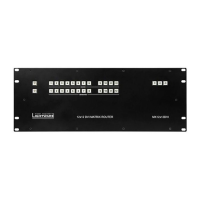
